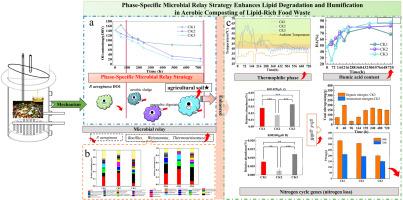阶段特异性微生物接力策略增强了富脂食物垃圾有氧堆肥中的脂质降解和腐殖化
IF 8.4
2区 环境科学与生态学
Q1 ENVIRONMENTAL SCIENCES
引用次数: 0
摘要
由于油引起的物理化学障碍(10%的油含量使孔隙率降低32 - 45%,并抑制微生物活性),富含油脂的食物垃圾在好氧堆肥中构成了重大挑战。为了弥补这一差距,我们设计了一种相特异性微生物中继策略,将铜绿假单胞菌DO1与来自农业土壤的嗜热菌(CK3)结合起来。结果表明,DO1通过脂肪酶分泌(121.18-131.45 U/mL)和脂质酶乳化作用,在96 h(45°C)内脂质降解率达到25%,之后其丰度从26.99%下降到8.41%。随后,ck3衍生的嗜热细菌(芽孢杆菌,38.54%;热放线菌(2.53%)和真菌(Wallemia, 21.12%)在嗜热阶段(50°C, 5 d)占主导地位,使β-氧化介导的脂质降解率达到91.91%,腐殖质降解率为92.74%。宏基因组分析证实了脂溶途径的富集(ko00071, p <;0.01)和氨同化基因(glsA/gdhB)的上调,使氮损失降低到25.1%。这种温度相位继电器策略能够有效地原位降解高脂废物(15%的油),为工业堆肥提供了可扩展的解决方案。本文章由计算机程序翻译,如有差异,请以英文原文为准。

Phase-specific microbial relay strategy enhances lipid degradation and humification in aerobic composting of lipid-rich food waste
Lipid-rich food waste poses significant challenges in aerobic composting owing to oil-induced physicochemical barriers (>10 % oil content reduces porosity by 32–45 % and suppresses microbial activity). To bridge this gap, we designed a phase-specific microbial relay strategy integrating Pseudomonas aeruginosa DO1 with thermophilic consortia derived from agricultural soils (CK3). The results demonstrated that DO1 achieved 25 % lipid degradation within 96 h (mesophilic phase, <45 °C) through lipase secretion (121.18–131.45 U/mL) and enzymatic emulsification of lipids, after which its abundance decreased (from 26.99 % to 8.41 %). Subsequently, CK3-derived thermophilic bacteria (Bacillus, 38.54 %; Thermoactinomyces, 2.53 %) and fungi (Wallemia, 21.12 %) dominated the thermophilic phase (>50 °C for >5 d), driving β-oxidation-mediated lipid degradation to 91.91 % and enhancing humification with 92.74 % humic substances. Metagenomic analysis confirmed the enrichment of lipolytic pathways (ko00071, p < 0.01) and the upregulation of ammonia-assimilation genes (glsA/gdhB), reducing nitrogen loss to 25.1 %. This temperature-phased relay strategy enables the efficient in situ degradation of high-lipid waste (>15 % oil), offering a scalable solution for industrial composting.
求助全文
通过发布文献求助,成功后即可免费获取论文全文。
去求助
来源期刊

Journal of Environmental Management
环境科学-环境科学
CiteScore
13.70
自引率
5.70%
发文量
2477
审稿时长
84 days
期刊介绍:
The Journal of Environmental Management is a journal for the publication of peer reviewed, original research for all aspects of management and the managed use of the environment, both natural and man-made.Critical review articles are also welcome; submission of these is strongly encouraged.
 求助内容:
求助内容: 应助结果提醒方式:
应助结果提醒方式:


